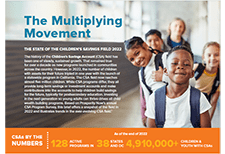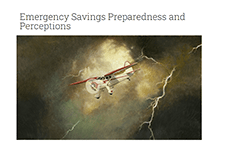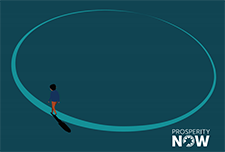Discover financial empowerment resources
Discover financial empowerment resources
The Multiplying Movement: The State of the Children’s Savings Field 2022 shares findings from Prosperity Now’s 2022 Children’s Savings Account (CSA) program survey. The report highlights the incredible growth of the field with over 4.9 million children and youth with CSAs across the US. In...

A good deal of attention has been paid to the question of what these high rates of inflation in housing and food costs mean for Canadians. Much of the concern has focused on the implications for middle-income Canadians hoping to purchase a home, while squeezing their household budgets. But what do...

According to Employee Benefit Research Institute (EBRI), workers with household incomes of $75,000 or more are more than twice as likely to say they feel they can handle an emergency expense than those with household incomes of less than $35,000. This report outlines the results of the 2022 survey...

The American Rescue Plan, one of the most significant policy responses to alleviate child poverty in decades, made fundamental changes in enhancing the Child Tax Credit (CTC). In response to the pandemic, the law expanded the CTC for tax year 2021 to ensure a minimum level of economic support to...

Workers earning low to moderate incomes (LMI) continue to face challenges in financial security. The COVID-19 pandemic exacerbated the financial situation of many workers earning LMI. Along with the current macroeconomic environment, it has become even more challenging to build liquid savings for...

In this webinar, Commonwealth in partnership with DCIIA Retirement Research Center (RRC) and SPARK Institute present findings from our new research about drivers and considerations of recordkeeper-provided emergency savings and host a discussion with industry...
The G20 Fukuoka Policy Priorities for Ageing and Financial Inclusion is jointly prepared by the GPFI and the OECD. The document identifies eight priorities to help policy makers, financial service providers, consumers and other actors in the real economy to identify and address the challenges...

This report examines data from the Federal Reserve System’s 2016 Survey of Consumer Finances to understand how the wealth of median Black, Latino and White families have changed since the findings of its previous survey were released in...

This report, 'The Perils of Living Paycheque to Paycheque: The relationship between income volatility and financial insecurity', examines the relationship between income instability and broader measures of financial well-being. This study makes use of a unique dataset that collected...

In this video presentation Johnathan Weisstub from Common Wealth discusses recent improvements in senior Canadians' poverty levels due to benefits such as OAS and GIS, and the challenges that still remain in ensuring retirement security for modest-earning and low-income Canadians. This...

Increasing interest in the role that consumer-focused policy interventions can play in improving economic outcomes has led to a host of intervention models in recent years. Financial coaching has emerged as one prominent model in this field, aimed at improving consumer financial outcomes by using...
This is the second in a series of briefs produced by a partnership between the Aspen Institute’s Expanding Prosperity Impact Collaborative (EPIC), Washington University’s Center for Social Development (CSD), and the Intuit Tax and Financial Center. The first brief highlighted new data on the...
The JPMorgan Chase Institute has assembled data assets and perspectives on income and spending volatility over the last three years and examined the impacts of extraordinary income changes from job loss and extraordinary expense changes, notably from medical payments. Here we take a holistic view...
This Economic Insights article documents the characteristics of families with children under the age of 18 who hold registered education savings plan (RESP) investments. The article also examines the relationship between holding an RESP account at age 15 and postsecondary enrolment between the ages...
This new Poverty Trends Scorecard consisting of four reports now presents an update of the information on income, wealth, and inequality. Over three years later, the recovery has yet to fully take hold. The individuals and families who bore the brunt of the 2008–09 recession face continuing...
This is a pre-budget presentation from the Government of Canada on the state of the middle class in Canada. Middle class challenges, successes, and government commitments. All Canadians benefit from strong, sustained, and inclusive economic growth and everyone has a real and fair chance at economic...
Modern financial planning is dominated by one topic: retirement planning. However, in spite of extensive study and wide attention, retirement savings rates remain perplexingly low and remarkably resistant to policy intervention. One approach that does seem to work is employer-based education....
In recent years, many states and some local governments implemented or expanded their own, supplemental Earned Income Tax Credit (EITCs). The expansion of state EITCs may have stemmed in large part from wanting to provide a more generous program than the federal program, because state EITCs...
This brief is the fourth of a five-part series that highlights the need and opportunity for integrating financial capability services into social service programs. The goal of this integration is to improve overall financial outcomes that lead to financial security for low- and moderate-income...
When household emergencies strike or there’s not enough in the bank to make it to the next paycheck, some families turn to small-dollar credit—small loans from alternative financial service (AFS) providers, such as payday lenders or pawnshops, or from mainstream sources. In October 2014, the...
...
This report focuses on the role that policy design can have on closing the country’s unrelenting and unacceptable racial wealth divide. We utilize a new framework—The Racial Wealth Audit—launched jointly by the Institute on Assets and Social Policy at Brandeis University (IASP) and Demos to...
The federal government’s decision this year to cancel family income splitting and lower the annual contribution limit for tax-free savings accounts was driven largely by concerns about income inequality. Research by the Canadian Centre for Policy Alternatives, Parliamentary Budget Officer and...
The Government of Canada is committed to strengthening the middle class and helping low-income Canadians exit poverty so that they have sufficient capabilities to be well and do well. To achieve this goal, we will need to form partnerships, modernize the existing landscape of supports and encourage...
There was a time, not very long ago, when Canadians were savers. In 1982, we routinely set aside 20 percent of our yearly income for large household purchases, education, starting businesses, retirement or just plain rainy days. Having a savings ‘nest egg’ was accepted wisdom and the norm. Then...
